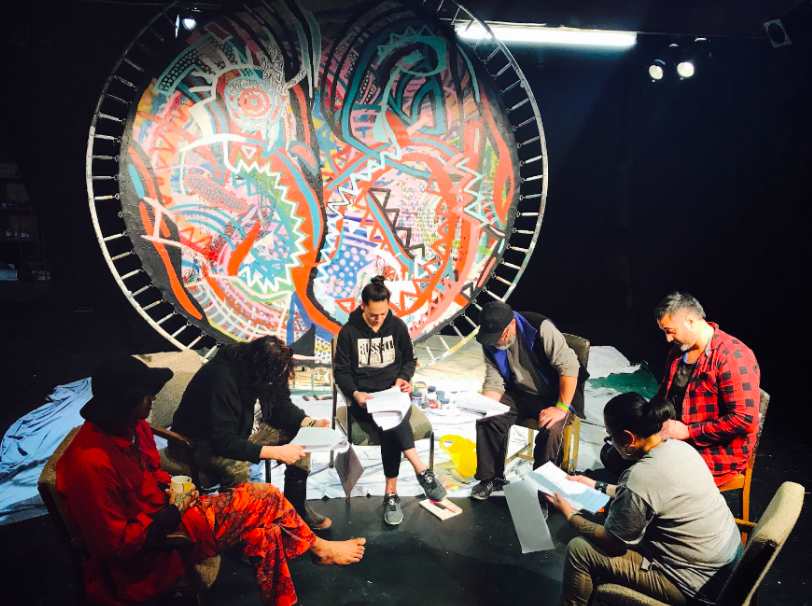NOA CAMPBELL
Noa and Kali Kopae. On set. Whina 2020
Ngunguru i te Ao i te Po- National Te Reo Season, written by Noa Campbell, commissioned by Taki Rua; second season at Capital E Festival Wellington. 2015
Solo Artist Residency. Lapua, Finland. 2019
Noa and Gaku Lapua Artist in residence. Finland 2019
Tika or Tika by Noa. 2015
I Am Noa directed by Scotty Cotter. Auckland Art Gallery 2015
Crossfire. Written and Directed by Noa Campbell. Maidment Theatre, Auckland 2013
River Queen. Director Vincent Ward. 2004
FEATURED: Noa Campbell - Ngāi Tūpoto, Te Waiāriki, Te Kaitutae, Ngāti Manu - Te Rarawa, Ngāpuhi
“He uri ahau nō Hokianga Whakapau Karakia, Ko Te Waiāriki ko Te Kaitutae, Ko Te Rarawa, Ngāi Tūpoto ngā hapū i te taha o tōku mama. I te taha o tōku papa nō Ngāti Manu ahau, nō Karetu. I whakatupu tēnei i roto i Hokianga Whakapau Karakia i reira i haere au ki te kura. I whāngai mai i āku tūpuna i ngā mea pai mai te whenua”.
Noa was raised in Motukaraka, on the north side of Hokianga. Then, at eight years old Noa and her siblings moved across the awa to Rawene in South Hokianga to go to school. “I runga i te wā kei Rawene mātou i hoki i ngā wa katoa ki te kainga ki te taha o āku mātua tūpuna, ki te whenua. Koira te wahi tino pai ki a matou nga tamariki i taua wa. Koirā te wahi i ako mātou ki te hakatupu kai haere ki te moana kohi kai, matakitaki ki ngā mātua tūpuna i hakarite ngā kai patu ngā kararehe wērā te momo mahi o te whenua. Erangi i te wa i noho matou ki Rawene he ao anō ki reira”. That really solid kāinga upbringing in Motukaraka as a small child would come to influence Noa later on in her life.
Noa was trained as an actor at New Zealand’s drama school, Toi Whakaari in Wellington, and later developed her skills into writing scripts for stage and directing stage. I timata tāna haerenga i te wa e tamaiti ana ki te kura, mahi i nga mahi kanikani.
When Noa went to Rawene school she was part of the Rarotongan dancing group, gymnastics, and netball, which she says are all forms of performance. Her first exposure to the arts was at Rawene Primary School, where she had a teacher, Mr Bonalec who made two films with his students about the environment. At this time there was no whakairo in any of the wharenui in Hokianga, nothing that told Noa that she was Māori. However, she saw art everywhere, even in the paintings of Jesus in the whare karakia.
Noa’s journey into performing arts started professionally when she was studying at Te Ataarangi learning how to speak Te Reo rangatira in Waikato. There she did a lot of singing. Te Ataarangi is taught in crimson blocks - you learn how to speak Māori by creating images and using the blocks to make sentences. They would also do little skits. It was here where Noa met one of her Harris whanaunga from Motukaraka who told her she should be an actor. For two years her cousin would say this to her.
Noa returned to Te Tai Tokerau in 1999 after living away for 18 years and her journey as a kaimahi toi started then. One of the reasons she wanted to come back home, apart from finding more support for herself and tamariki, was that she could engage with wānanga from her Ngāpuhi experience and her Ngāpuhi people. As well, she started training in mau rākau with Heemi Titan and Manu Korewha. She was a part of the first intake of the north in the revitalisation of mau rākau in Te Tai Tokerau. This was also a great way for her to hakapakari her reo. “Te katoa o ngā wānanga i roto i te reo. He wahi hoki tēnei hei hakawhanaunga ki ngā tangata o konei.” At this same time, Noa started working at 155 on Kamo Road. She volunteered to do drama classes with the alternative education school. On Friday mornings she would do a couple of hours of drama with them and at the end of each term their families would be invited to come and see what they had created over that term. Noa recalls this time as reclaiming her Ngāpuhitanga.
Noa completed a certificate in performing arts at Northland Polytech and that same time, she engaged with a wāhine roopu that were doing playback theatre which is a form of theatre in which the audience tell stories from their lives and watch them enacted on the spot. Puti Lancaster was the driving force of this roopu. This was a group of wāhine Māori that were living in Hokianga and Whangārei and they would come together once a month and wānanga. No one was an actor except for one person: they just had an interest in this kaupapa. They would then go into the community and work doing playback theatre.
This roopu performed at the Magdalena festival in Paekakariki and Wellington City. This was a life-changing experience for Noa. After one of the shows, the movement teacher from Toi Whakaari approached Noa and said she should audition for NZ drama school. At that time Noa didn’t know about Toi Whakaari, but she came away from there with that seed sown in her. Noa decided to audition for Toi Whakaari and very naively had no idea how prestigious it was. She says that sometimes ignorance is good.
There were massive sacrifices to go to drama school. Noa had to leave her family and her children went back and lived with their dad during term time. She explains that this was a very privileged journey but came with great sacrifices. Toi Whakaari was not an easy place to be as a mum because you have to give your life to the school. One of the challenges in Noa’s career has been a lack of roles. Many roles that are written for Māori women are usually kuia or dumb, funny woman. There is lots of typecasting and stereotyping. Only in about the last seven years have there been more Māori writers in film. Noa adds that we should be writing more toa characters for wāhine Māori. Another challenge has been living sustainably as an artist. Noa moved into writing and directing because she wasn’t getting enough acting work.
Noa completed a one month artist residency in Finland through the Von Haux Cultural Residency. Noa’s mahi there was to create a response to works in that gallery. There was one artist whose work spoke to Noa. This wahine had created works of photographs that were 100-years-old of people who had lived in that part of Finland. This reminded Noa of our whare tupuna and how we keep photos of our tupuna.
The unique skill set that Noa brings to her mahi is physicality. Because of her training at Toi Whakaari she uses a lot of physicality when she's developing a character - she needs to give herself something physical to anchor herself to that character. Noa has consciousness around the body and the breath and says that they are our biggest tools. What also sets her apart is that she has a strong sense of identity, which is a good foundation to work from. She can access things quickly and believes that is because she is solid in who she is as a person.
As a wahine Māori, Noa’s biggest inspiration has been Eva Rickard and as a filmmaker Merata Mita has been her biggest inspiration. Noa explains that Eva Rickard was not only a Māori activist but loved the arts. When they got their whenua back in Whaingaroa, she set up lots of work schemes there, and brought international Indigenous people to that whenua for arts festivals. In more recent years, Noa’s mum has been an inspiration because she’s a kuia and she’s still holding it down for their whānau. She is well-connected in the community and has worked for Ngāti Hine Health for many years. Noa says that she’s a good example of mana wāhine.
Noa’s process to toi Māori is that if it's her own project she will bring people together and have some whakawhanaungatanga, have some kai, and ask people to rangahau about what they are about to embark on. During rehearsal time, the first part of the morning is to korikori tinana i mua i te mahi - start with a physical and vocal warm up. Whakawhanaungatanga and manaakitanga are really important to Noa’s process. “Ko te mahi whakaari e whakakoi te hinengaro, whakakoi te whānau hoki”.
Noa says that Māori are in a really good position at the moment and it’s an exciting time, as we have more Māori producers, directors and actors. There has been funding recently given from the Culture and Heritage Fund for actors and dancers based in Te Tai Tokerau to hui and develop a Māori arts community in whakaari and kanikani in the North. This tono for kaimahi was made by Ngā Hua Toi which is a group of producers and directors from all over the motu. There were four rohe that got funded to do this. Noa says she has felt isolated and lonely at times because there hasn’t been a Ngāpuhi arts or theatre community but that’s about to change.
Noa has developed a solo show alongside Puti Lancaster (who passed away in late 2021) called Hokianga meets Chic which focuses on the realisation Noa had as a wahine Māori in her 20s that she had been through assimilation at a young age. It is about her lived experience on the kāinga and then moving across the awa to Rawene and going through assimilation. Hokianga meets Chic is also about her journey “ki te whakaora tōku ao Māori me tōku reo”. Puti really pushed Noa to develop this solo show. Puti’s method was to work with lived experience and the process had them working with Puti’s original 36 pages which they then refined to two decades of Noa’s life.
Currently, Noa is part of a tv series called The Brokenwood Mysteries. She is enjoying this mahi and explains that she is working with creme de la creme artists. The rewards in Noa’s career have been the appreciation of audiences when you perform, sometimes in little communities that don’t have a lot of theatre come to them. Another reward has been working alongside some quality actors. Noa’s first feature film was River Queen alongside Cliff Curtis.
Noa’s mahi has rubbed off on her tamariki, as three out of four of her tamariki are artists. Her kids have been brought up around some great artists, and are good at critiquing shows. Noa says that creativity is one of the āria that is in our DNA as Māori. A whakataukī that resonates with Noa is ‘toitū te kupu, toitū te mana, toitū te whenua’.
Written by Tai o Hī Tai o Hā Writing Intern Dina McLeod (Ngāti Wai, Ngāti Hine, Ngāpuhi)








